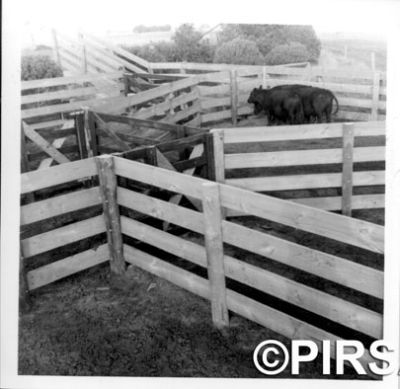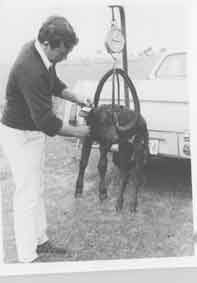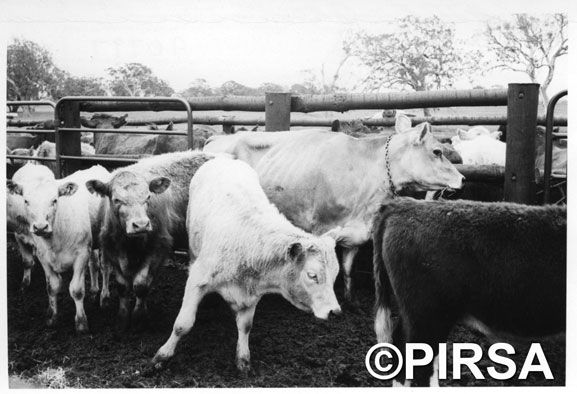Sundries
Fencing

Photo No.: 103749 Title: Cattle yard where all the posts are driven into the ground. Date: 11 Mar 1964
As colonists expanded their herds, hedges or walls were impractical in the extensive areas to be contained. Without fences their ability to utilise all available pasture was limited by the capacity of the shepherds to control the stock but by 1868 “Pastoral Pioneers of SA” records both P Waite and HB Hughes using fencing to replace shepherds. In 1870 and 1871 Waite imported from England 265 tons of wire for fencing to create paddocks. This was a critical turning point in the management of sheep and cattle in the large scale operations in South Australia.
The heavy gauge wire and locally split posts formed the basis of fencing in South Australia for the best part of a century. High tensile wire and a shortage of local timber led to concrete posts, then treated pine posts and to long spans using high tensile wire.
Identification
Identification has always been an important aspect of extensive beef cattle management, initially as a method of proof of ownership either because of theft or when herds became mixed for some reason.

Photo No.: 106109 Title: Calves were weighed and tattooed on the ear at birth at the Struan Research Centre. Date: 28 Mar 1973
As it became necessary to identify individual animals for stud breeding purposes or to record individual production data the process became more difficult and numerous attempts have been made to find an efficient, safe and reliable means of identification.
The various Brands Acts relied on the traditional firebrand method as a permanent identification of ownership and generally it has been highly successful although, inappropriately applied brands significantly reduce the value of the hide.
Tattoos in the ears proved suitable to identify individual stud animals but with the disadvantage that they had to be individually restrained to be read. Freeze branding was tried in the seventies with an elaborate roman numerals type code to simplify the branding process. Over many years numerous types of ear tags have been utilised for individual identification but none are failsafe.
Temporary tailtags (ratchet and wrap around) were successfully developed as part of the BTB program to track animals through the saleyard and slaughter process to provide traceback of diseased animals back to the property of origin.
Consumers now require assurance that food products are safe from micro organisms and chemical residues. Procedures are in place to test products in the marketing chain and it is then essential to be able to trace the problem back to the animal at the abattoir and then to originating property to implement preventative action. For example in 1987 US authorities detected organochlorine residues in imports of Australian beef risking the invaluable US beef market. Food safety incidents in beef were occurring at the rate of two per year in 1997. The ability to be able to trace animals throughout their lifetime is essential for the control of chronic animal diseases such as Johnes Disease and Enzootic Bovine Leucosis.
In 1999 following a number of organochlorine, HGPs (Hormone Growth Promotant) and other residue incidents, a voluntary cattle accreditation scheme for cattle exported to the European Union was launched. This scheme required electronic identification of all cattle involved, accredited saleyards and abattoirs. This was the forerunner to the compulsory electronic identification scheme which was phased in from January 2004. By 2006 it was fully operational and tailtags were phased out.
In conjunction with this owners can, with the use of an electronic reader, identify individual cattle for selection or production records throughout the animals life.
Dairy Cattle Influence
Surplus calves bred by the dairy industry have always been a source of beef animals. At the time milk was paid for by the percentage of butter fat produced, jerseys were the most popular dairy breed but their progeny were rarely used to produce beef resulting in most dairy calves being slaughtered within a few weeks of birth for veal. As cross breeding became more popular and the friesian became the dominant dairy cow more calves were reared to yearlings or older for beef.

Photo No.: 103671 Title: Hereford and Charolias breed cattle crossed with Jersey cattle. Date: Sep 1970
